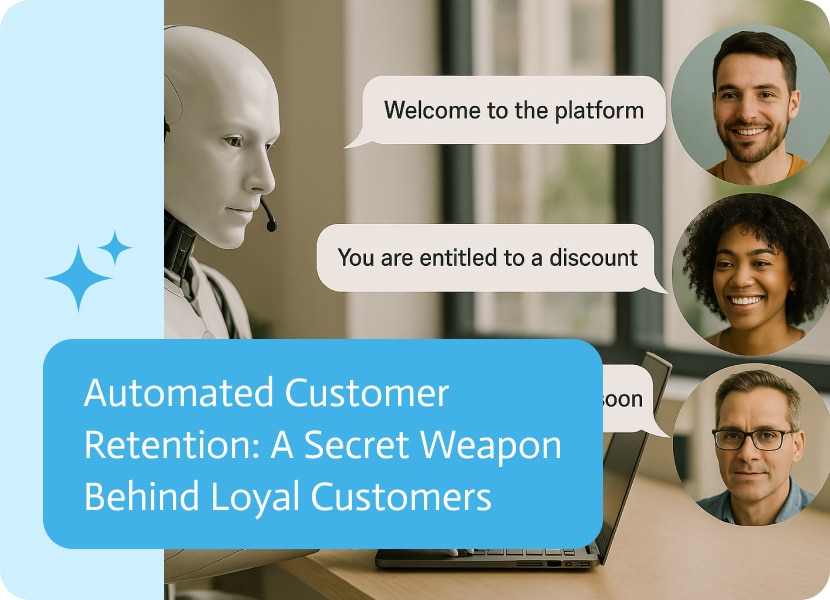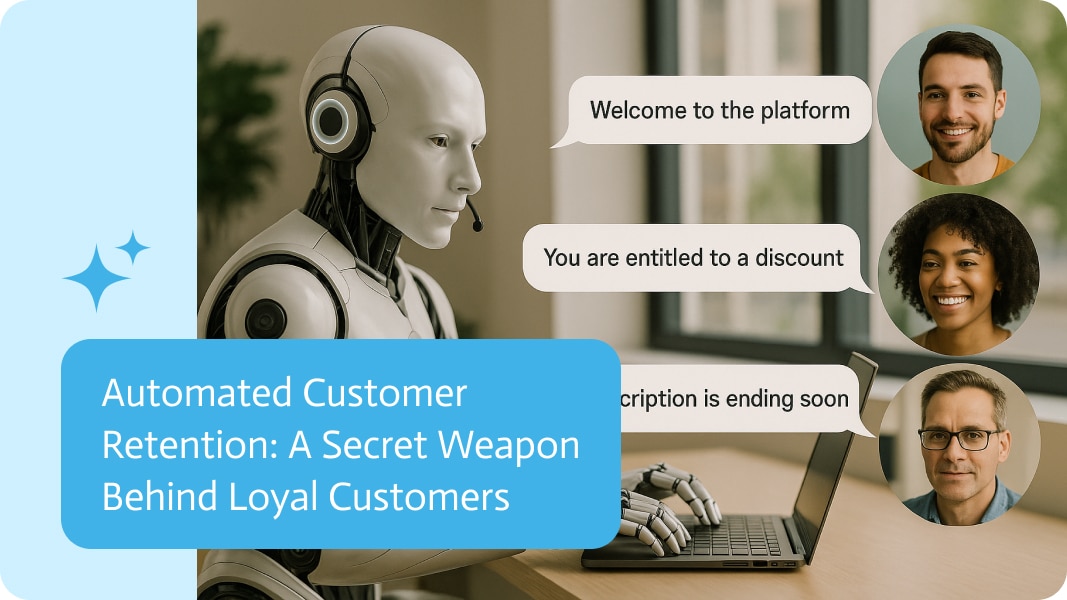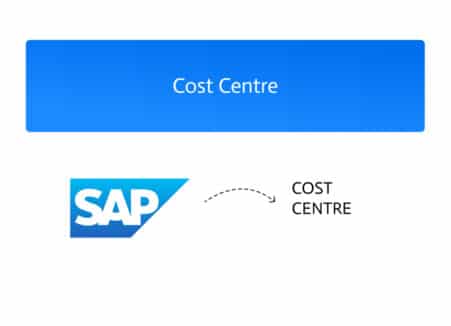

Automated Customer Retention: A Secret Weapon Behind Loyal Customers
Automated customer retention means using tech, specifically software and artificial intelligence, to keep your current customers happy and loyal. The goal is to do this without a human team constantly intervening.
Think of it as having a digital team that works 24/7 to stop your customers from switching to another company. Companies use ai automation agent tools to handle customer retention, so they don’t have to rely on sales reps or support staff for constant check-ins.
These days, getting customers is only half the battle, keeping them is the real trick, and that’s where automated customer retention comes in. Smart businesses are using this to keep more customers, lower churn, and maximise profits in a big way.
What Is Automated Customer Retention?
At its core, automated customer retention is the use of technology, like CRM systems, AI, and marketing automation, to keep your existing customers happy without the constant hands-on effort.
Rather than chasing down users with phone calls or manually sending follow-ups, businesses implement systems that handle key retention tasks like:
- Monitoring the behaviour of your customers
- Identify at-risk customers
- Sending personalized messages
- Delivering timely offers
- Managing feedback loops
The goal? To proactively prevent churn, deepen loyalty, and increase customer lifetime, all on autopilot.
Why Retention Matters More Than Ever
Rip open your budget sheet, and you may wince: landing a brand-new customer eats up five to seven times the cash needed to keep one who already likes you. Shocking, right?
Even so, tons of brands chase shiny sign-ups while shrugging at the crowd already knocking at their door. That choice drags profits through the mud.
Bain & Company says a mere 5% bump in holding onto buyers can swell your bottom line by anywhere from 25% to 95%. Suffice it to say that kind of jump is the sort of thing that keeps CEOs awake in a good way.
Retention goes beyond a warm-and-fuzzy bonus, it’s a booster rocket for revenue, plain and simple.
Key Benefits of Automated Customer Retention
Scalability
Humans can only shake so many hands in a single day, so automation steps in to deliver friendly nudges even while you sleep. The message gets personal, the brand looks consistent, and the growth numbers keep climbing, no matter how swamped you get.
Efficiency
Your brightest people should be out solving sticky problems, not sending the same welcome note a thousand times. When bots handle weekly check-ins and gentle upsell pokes, the team finally has room to breathe and actually connect.
Data-Driven Decisions
Smart systems stash and sift through customer clicks, opens, or silent stalls, lighting up the danger signs before you lose a buyer. Spotting churn risks instantly feels almost unfair in the best possible way.
Revenue Growth
Delighted shoppers drift back, drop extra dollars, and drag their friends along for the ride. An automatic thread of value grabs them from that first welcome email all the way to the renewal page that comes later on.
The Building Blocks of Automated Retention
Let’s uncover what’s happening and figure out what really holds an automated retention plan together, one building block at a time.
1. Customer Behavior Tracking
You can’t fix what you can’t see. To keep folks around, start by peeking inside your own product:
- Who opens the app today? Who logged off last month and forgot the password?
- How often are the die-hards tapping buttons versus the one-time tourists?
- What shiny features keep drawing eyes, and where do people hit the exit ramp?
Mixpanel, Amplitude, or even the trusty HubSpot and Salesforce logs will tell you the story if you listen closely. Couple those numbers with Hotjar heatmaps or FullStory session replays, and the picture sharpens, becoming clearer to you.
Just think if someone skips a key onboarding step and doesn’t show up for 10 days. Boom, an automated email asks if they need a hand, or a gentle in-app nudge pops up the minute they return.
2. Personalized Lifecycle Messaging
Mass emails that say, We miss you! feel like canned soup: cold and bland. Real retention works in real time, serving up messages that seem as if they were written just for today.
- A brand-new user might get a step-by-step welcome tour that unlocks one task at a time.
- Someone who just built their first dashboard gets a note that says, Here’s what you can do next.
- A long-absent account receives a tiny tutorial link, framed as Just in case you’re still stuck.
- When renewal time rolls around, an early-bird discount flashes before anyone thinks to cancel.
Platforms like Intercom, Braze, and Customer.io wire all this together, while ActiveCampaign or Klaviyo handle the email legwork.
3. Loyalty & Rewards Programs
Nothing says Come back soon, like a little bonus in your back pocket. Automatic points, referral dollars, or tier badges make customers feel like they own a backstage pass. That emotional ownership turns casual users into vocal fans.
Build a little background engine that tracks how many points each shopper earns. Customers hate wondering where their balance stands.
- Celebrate birthdays. Set the system to send a small gift or a coupon when someone hits a birthday or another milestone. People like free stuff on their special days.
- Share the referral bonus. Fire off bonuses automatically when a friend signs up through a referral link. This can include the user and their wallet without extra clicks.
- Decide Who the VIPs Are. Create rules that slide frequent buyers and high spenders into a VIP list. Pair that with private deals they can only see.
- Recommended Tools. Put Smile.io or LoyaltyLion in your toolkit for points, tiers, and popups. Grab an app from the Shopify store and watch it talk to your checkout in seconds.
- Pro Tip. Every once in a while, give a loyal customer an unexpected treat. The surprise keeps them smiling and coming back.
Churn Prediction and Prevention
Spot Potential Leavers
A churn model looks at old patterns and fresh signals to rank who might bail. Stop guessing and start reading the data tea leaves.
Warning Signs
Watch for an account that suddenly logs in less, files more tickets, or pipes up with low NPS. Half-finished onboarding also screams for attention.
What to Automate
Have a flag flipped so the support team reaches out first. Follow up with a discount or a success call to turn the tide.
Platforms to Explore
Gainsight and ChurnZero let SaaS companies tag and track risk. Pop an AI layer on HubSpot or Zendesk and score customers on the fly.
Automated Feedback Loops
Collect Opinions without Bothering
Set surveys on cruise control so you get answers and not nagging. Continuous listening is cheaper than last-minute fixes.
Typical Automations
Shoot out an NPS survey 30 days after onboarding, ping micro-surveys inside hot features, and run cancellation forms when someone pulls the plug.
Suggested Tools
Use Delighted or Typeform, then link answers to Salesforce with Noca. SurveyCat can run in-app and dump results where you need them.
Fine-Tune Based on Voice
Take feedback, twist it into product tweaks, and fine-tune your retention game. An engaged customer is one who feels heard.
Putting It All Together:
Let’s say you run a subscription-based task management app. Here’s what an automated retention funnel might look like:
Week 1 Onboarding:
- User signs up → Trigger welcome email
- Completes tutorial → Unlock reward badge
- Doesn’t complete onboarding → Trigger reminder + video walkthrough
Week 3 Engagement:
- User creates 3 tasks → Send “power user” tips
- Stops logging in → Send a “We miss you” email with productivity tips
- Opens but doesn’t engage → Trigger in-app chat offering help
Month 2 – Risk of Churn:
- Usage drops 50% → Flag in CRM
- Trigger a 15% discount offer or an invite to a 1:1 call
- No response → Enroll in “win-back” campaign
Month 3 – Renewal Period:
- Automate reminders and personalized messages
- Offer a bonus month or loyalty perks
- Survey users post-renewal for NPS insights
All of this happens automatically using a combo of your CRM, email tool, and product analytics platform.
Best Practices For Automated Customer Retention
Even though automation can supercharge your customer retention, it’s only as effective as the strategy behind it. It’s somewhat like a self-driving car: it’s powerful, but you still need to plot the right course, check the fuel, and keep your eyes on the road. Here’s how to make sure your automation isn’t just “working” but winning.
1. Start with the Data: Garbage In, Garbage Out
Your automation is only as smart as the data you feed it. If you’re working with incomplete, outdated, or error riddled customer data, your retention strategy will struggle, or worse, alienate customers.
What this means in practice:
- Keep your data clean by removing repeats, completing missing info, and deleting old contacts on a regular basis.
- Collect data on what people do, not just who they are. Knowing Sarah is a Pro Plan user is good, but knowing she hasn’t logged in for a week, didn’t do the onboarding, and only uses one of the five features is way more helpful.
- Connect all your systems. Integrate your CRM, analytics, email, and support logs. Separate data leads to separate experiences.
Keep every tool in sync. Use Segment, RudderStack, or Noca to funnel customer data so it flows in one clean stream that updates while you blink.
2. Segment Intelligently: One-Size-Fits-None
Treat your customers like they matter, because they do. Separate groups want specific messages, and good segmentation lets you hit the sweet spot every time.
Useful segmentation methods:
- Plan type: Free trial, monthly subscriber, annual VIP.
- Engagement level: Daily super-users, casual weekend check-ins.
- Lifecycle stage: Brand-new sign-ups, mid-point champs, renewal-needing vets.
- Purchase history: Big spenders, discount hunters, and one-and-done shoppers.
- Support interaction: Users who just filed a ticket, clients with unresolved issues.
Tools to help: CRMs like HubSpot, Customer.io, or Klaviyo slice and dice lists on the fly based on what people actually do right now.
3. Keep It Human: Nobody Likes a Robot
Automation is great, but it shouldn’t turn your voice into an echo. Customers can smell a canned message from a mile away, so write notes that feel like they came from a neighbor, not a program.
How to Humanize Automation
1. Use the customer’s first name. Sprinkle it in once or twice, but don’t turn every line into a pep rally.
2. Reference something they actually did. Say, We saw you uploaded your first file, great job! That little nod makes the message land.
3. Swap formal speech for friendly chatter. Buzzwords like “leverage” and “synergy” can stay in the boardroom where they belong.
4. Add real faces. Signing off with Lena from Customer Success, and a quick photo of her smiling keeps things personal.
5. Show a bit of empathy. Try. We noticed you haven’t logged in lately, totally understandable. Life gets busy! It softens the task.
What Not to Do
Avoid the lines, “Dear Customer, you are invited to optimize your usage metrics. Please comply to enhance ROI”. That kind of prose sounds like a parking ticket.
Rather say something like, Hey, Taylor! Just checking in-we haven’t seen you around in a bit. Need help getting back on track? That feels more like a friend than a form letter.
Test and Optimize: Set-and-Forget Is a Trap
No automation is perfect right out of the box. What works today might flop tomorrow, and the only way to know is to watch.
Regularly test and tweak your retention flows if you want them to stick around for the long haul. A little upkeep today saves a lot of headaches next month.
What to Test
- Subject Lines and Tone: Swap out headlines and measure which feel warmer or clearer. Small tweaks can feel big to readers.
- Timing: Try nudging folks on Day 3, then Day 7, and see when they’re most chatty.
- Calls to Action: Move buttons, rewrite the anchors-fix the phrases that either spark clicks or leave people scrolling.
- Channels: Shoot the same message once by email, once by SMS, and once in the app. Some folks live in one inbox; others in another.
- Offer Types: Run head-to-heads between a straight discount, a trial bump, and an upgrade ask. What lightest push turns a curious person into a customer?
Tools That Help
Built-In A/B Features: Most email suites let you batch-test subjects, layouts, and even headlines with one blast.
Multivariate Engines: VWO or Optimizely can juggle four or five variables at once, though they involve a steeper learning curve.
Analytics Dashboards: Chart open rates, clicks, and money-in vs. money-out until trends stop being wishes and start being facts.
Iterate Often: Picture automation as a garden, not a sprinkler left running. Every three months, yank the weeds, cheer the new blooms, and swap tasks that lost their shine.
Use Automation to Support Humans, Not Replace Them
A robot should assist a human, not elbow them offstage. Sensitive accounts or tangled questions still crave a voice, not a voicemail tree.
Blend Automation With a Human Touch
- Auto-Escalation Rule: If a frustrated client replies, flag a rep before the next coffee break.
- Scheduled Human Follow-Ups: An enterprise customer who ghosted for ten days pings their own success manager, not the general broadcast bot.
- Pre-Call Summaries: Pull together recent logins, tickets, and chats so the customer success lead steps into the call with fewer ‘uhhhs.’
Spot the people who might cancel their subscription before they actually pull the plug. Give your customer team a fighting chance to reach out and turn things around.
Tech plus a personal touch equals serious results.
Smart tools don’t have to feel robotic. Turn your automation into a friendly hand so the brand’s warmth and the team’s empathy can wrap around thousands of customers-without exhausting the crew.
Final Thoughts
Automated customer retention isn’t about cutting corners; it’s about amplifying your ability to care at scale. With the right strategy and tools, you can engage users proactively, prevent churn before it starts, and turn casual customers into raving fans without manually chasing them down every week.
In the age of automation, retention isn’t just easier, it’s smarter, faster, and more profitable.


